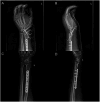A novel injury mechanism of trans-styloid palmar-divergent dislocation of the lunate and scaphoid: a case report
- PMID: 40256416
- PMCID: PMC12006045
- DOI: 10.3389/fsurg.2025.1526008
A novel injury mechanism of trans-styloid palmar-divergent dislocation of the lunate and scaphoid: a case report
Abstract
Background: Palmar-divergent dislocation of the lunate and scaphoid is a rare high-energy trauma with complex injured mechanism. Early diagnosis and surgery are necessary, however, there is no consensus on surgical treatment, as only a few literatures have been reported.
Case summary: A 56-year-old man, following a powerful strike to the dorsal side of left wrist and forearm, complained about swelling, tenderness, and limited motion of the left wrist during the physical examination. According to physical and imaging results, this patient was diagnosed with trans-styloid palmar-divergent dislocation of the lunate and scaphoid, as well as radial diaphysis fracture. We performed open reduction, internal fixation with K-wires, ligament reconstruction, and cast immobilization for 6 weeks, followed by early rehabilitation.
Conclusion: We firstly described a novel injury mechanism of trans-styloid palmar-divergent dislocation of the lunate and scaphoid based on the classical Mayfield's mechanism, and reviewed suggestions regarding the optimal treatment of palmar-divergent dislocation of the lunate and scaphoid.
Keywords: ORIF; lunate dislocation; palmar-divergent injury; scaphoid dislocation; scapholunate dissociation.
© 2025 Wang, Qu, Kang, Cui, Wang, Li and Xu.
Conflict of interest statement
The authors declare that the research was conducted in the absence of any commercial or financial relationships that could be construed as a potential conflict of interest.
Figures




Similar articles
-
[Scaphoid and lunate palmar divergent dislocation. Apropos of a case].Rev Chir Orthop Reparatrice Appar Mot. 1997;83(3):265-9. Rev Chir Orthop Reparatrice Appar Mot. 1997. PMID: 9255363 French.
-
Palmar-divergent dislocation of the scaphoid and lunate treated using percutaneous pinning and pin-in-plaster: A case report.Acta Orthop Traumatol Turc. 2020 May;54(3):348-352. doi: 10.5152/j.aott.2020.03.285. Acta Orthop Traumatol Turc. 2020. PMID: 32442125 Free PMC article.
-
Palmar divergent dislocation of scaphoid and lunate.Yonsei Med J. 2003 Dec 30;44(6):1091-3. doi: 10.3349/ymj.2003.44.6.1091. Yonsei Med J. 2003. PMID: 14703622 Review.
-
Case Study: Trans-styloid, Trans-scaphoid, Trans-triquetral, and Perilunate Dislocation.J Orthop Case Rep. 2021 Jun;11(6):63-67. doi: 10.13107/jocr.2021.v11.i06.2260. J Orthop Case Rep. 2021. PMID: 35437506 Free PMC article.
-
[Peri-lunate wrist dislocation: long-term outcome].Rev Chir Orthop Reparatrice Appar Mot. 2003 Jun;89(4):320-32. Rev Chir Orthop Reparatrice Appar Mot. 2003. PMID: 12844035 Review. French.
References
Publication types
LinkOut - more resources
Full Text Sources
Miscellaneous

